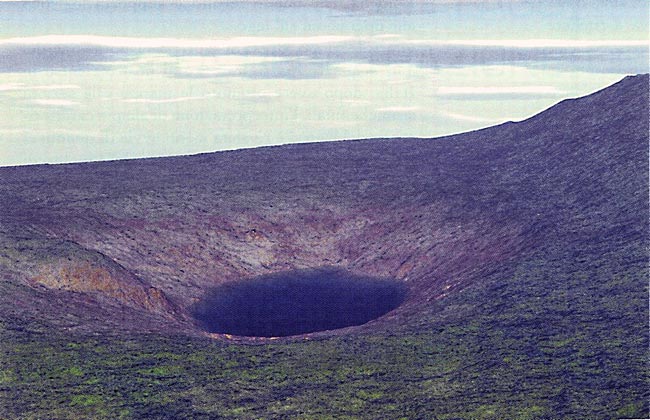Crater Could Solve 1908 Tunguska Meteor Mystery

In late June of 1908, a fireball exploded above the remote Russian forests of Tunguska, Siberia, flattening more than 800 square miles of trees. Researchers think a meteor was responsible for the devastation, but neither its fragments nor any impact craters have been discovered.
Astronomers have been left to guess whether the object was an asteroid or a comet, and figuring out what it was would allow better modeling of potential future calamities.
Italian researchers now think they've found a smoking gun: The 164-foot-deep Lake Cheko, located just 5 miles northwest of the epicenter of destruction.
"When we looked at the bottom of the lake, we measured seismic waves reflecting off of something," said Giuseppe Longo, a physicist at the University of Bologna in Italy and co-author of the study. "Nobody has found this before. We can only explain that and the shape of the lake as a low-velocity impact crater."
Should the team turn up conclusive evidence of an asteroid or comet on a later expedition,when they obtain a deeper core sample beneath the lake, remaining mysteries surrounding the Tunguska event may be solved.
The findings are detailed in this month?s online version of the journal Terra Nova.
Submerged evidence
Breaking space news, the latest updates on rocket launches, skywatching events and more!
During a 1999 expedition, Longo's team didn't plan to investigate Lake Cheko as an impact crater, but rather to look for meteoroid dust in its submerged sediments. While sonar-scanning the lake's topography, they were struck by its cone-like features.
"Expeditions in the 1960s concluded the lake was not an impact crater, but their technologies were limited," Longo said. With the advent of better sonar andcomputer technologies, he explained, the lake took shape.
Going a step further, Longo's team dove to the bottom and took 6-foot core samples, revealing fresh mud-like sediment on top of "chaotic deposits" beneath. Still, Longo explained the samples are inconclusive of a meteorite impact.
"To really find out if this is an impact crater," Longo said, "we need a core sample 10 meters (33 feet) into the bottom" in order to investigate a spot where the team detected a "reflecting" anomaly with their seismic instruments. They think this could be where the ground was compacted by an impact or where part of the meteorite itself lies: The object, if found, could be more than 30 feet in diameter and weigh almost 1,700 tons — the weight of about 42 fully-loaded semi-trailers.
Caution for now
From a UFO crash to a wandering black hole, wild (and wildly unsupported) explanations for the Tunguska event have been proposed. Alan Harris, a planetary scientist at the Space Science Institute in Boulder, Colorado, said the proposal by Longo's team isn't one of them.
"I was impressed by their work and I don't think it's something you can wave off," said Harris, who was not involved in the research.
Longo and his team "are among the recognized authorities on Tunguska" in the world, Harris told SPACE.com. "It would be thrilling to dig up chunks of the meteor body, if they can manage to. It would lay the question to rest whether or not Tunguska was a comet or asteroid."
Some researchers, however, are less confident in the team's conclusions.
"We know from the entry physics that the largest and most energetic objects penetrate deepest," said David Morrison, an astronomer with NASA's Ames Research Center. That only a fragment of the main explosion reached the ground and made a relatively small crater, without creating a larger main crater, seems contradictory to Morrison.
Harris agreed that physics could work against Longo's explanation, but did note that similar events — with impact craters — have been documented all over the world.
"In 1947, the Russian Sikhote-Alin meteorite created 100 small craters. Some were 20 meters (66 feet) across," Harris said. A site in Poland also exists, he explained, where a large meteor exploded and created a series of small lakes. "If the fragment was traveling slowly enough, there's actually a good chance (Longo's team) will unearth some meteorite material," Harris said.
Longo's team plans to return to Lake Cheko next summer, close to the 100th anniversary of the Tunguska Event. "This is important work because we can make better conclusions about how cosmic bodies impact the Earth, and what they're made of," Longo said. "And it could help us find ways to protect our planet from future impacts of this kind."
Dave Mosher is currently a public relations executive at AST SpaceMobile, which aims to bring mobile broadband internet access to the half of humanity that currently lacks it. Before joining AST SpaceMobile, he was a senior correspondent at Insider and the online director at Popular Science. He has written for several news outlets in addition to Live Science and Space.com, including: Wired.com, National Geographic News, Scientific American, Simons Foundation and Discover Magazine.
